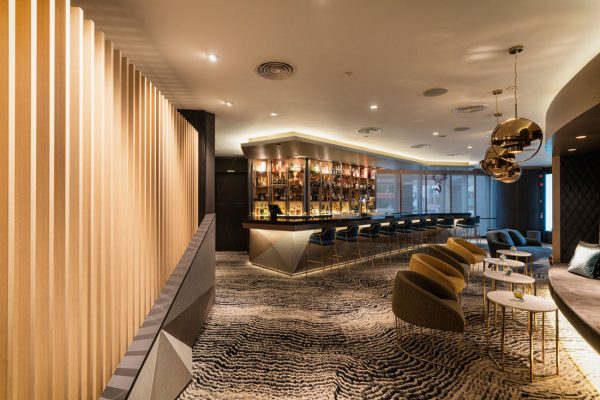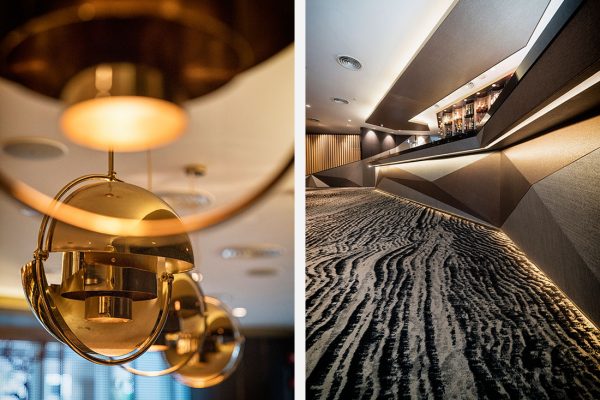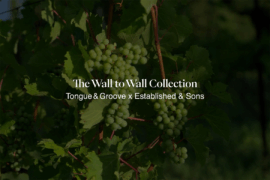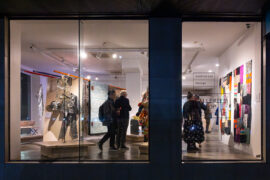Topos Design Studio’s Joji Bar at the Carlton Hotel diplomatically mediates the space between the hotel’s drop-off, lobby and Michelin-star restaurant with shapes inspired by origami.

November 30th, 2017
Three months and a long, narrow space were all Alan Fan of Topos Design Studio had to design and build a whiskey bar from scratch at the Carlton Hotel. In addition of being worthy of the hotel brand, this whiskey bar also had to be worthy of its neighbour, the Japanese restaurant Shinji by Kanesaka – a branch of the Michelin-starred omakase restaurant of the same name in Ginza, Tokyo.
The result is not disappointing. Joji Bar is a handsome and inviting venue that gently mediates the hotel’s lobby, drop off and the award-winning restaurant. The interior palette is warm, dominated by muted gold and padded surfaces in earthy tones, and accentuated by polished, brushed and perforated brass.

Cosy nooks and smaller sitting areas line one side of the room while a sculptural bar – the venue’s main feature – occupies another. The bar extends to the far end of the space, where the shape is slightly ‘folded’ to create a seating area where bar patrons can sit facing each other.

Fan borrowed the concept of Joji’s interior from origami, elegantly articulated with the shape of the bar and the ‘folding lines’ of the acoustic wall panels. “One of the main considerations for the space was the acoustics – it must be good enough so that you can hear each other when you sit together,” says Fan. “It was an opportunity to play around with the origami concept to complement Shinji’s design and give character to the whole space,” he says of the acoustic panels he incorporated.

And not just plain old origami; Fan’s origami concept is more specific – ‘an origami floating in tides’, symbolising Joji’s location as a connector between several areas in the Carlton Hotel, as much as being a destination in its own right. Reinforcing this concept and adding an extra dose of visual interest to the space is the black and white Tide carpet with a tide print from Danish brand Ege. Designed by Tom Dixon, Tide was inspired by the waves of the Thames in London. “It represents the ebbs and flows of the bar patrons,” says Fan.
INDESIGN is on instagram
Follow @indesignlive
A searchable and comprehensive guide for specifying leading products and their suppliers
Keep up to date with the latest and greatest from our industry BFF's!

Welcomed to the Australian design scene in 2024, Kokuyo is set to redefine collaboration, bringing its unique blend of colour and function to individuals and corporations, designed to be used Any Way!
The new range features slabs with warm, earthy palettes that lend a sense of organic luxury to every space.

London-based design duo Raw Edges have joined forces with Established & Sons and Tongue & Groove to introduce Wall to Wall – a hand-stained, “living collection” that transforms parquet flooring into a canvas of colour, pattern, and possibility.

For Aidan Mawhinney, the secret ingredient to Living Edge’s success “comes down to people, product and place.” As the brand celebrates a significant 25-year milestone, it’s that commitment to authentic, sustainable design – and the people behind it all – that continues to anchor its legacy.
The internet never sleeps! Here's the stuff you might have missed

The Australian Design Centre (ADC) has announced that the organisation can no longer continue without adequate government funding to cover operational costs.

Central Station by Woods Bagot in collaboration with John McAslan + Partners has been named one of two joint winners of The Building category at the INDE.Awards 2025. Recognised alongside BVN’s Sirius Redevelopment, the project redefines Sydney’s historic transport hub through a transformative design that connects heritage with the demands of a modern, growing city.